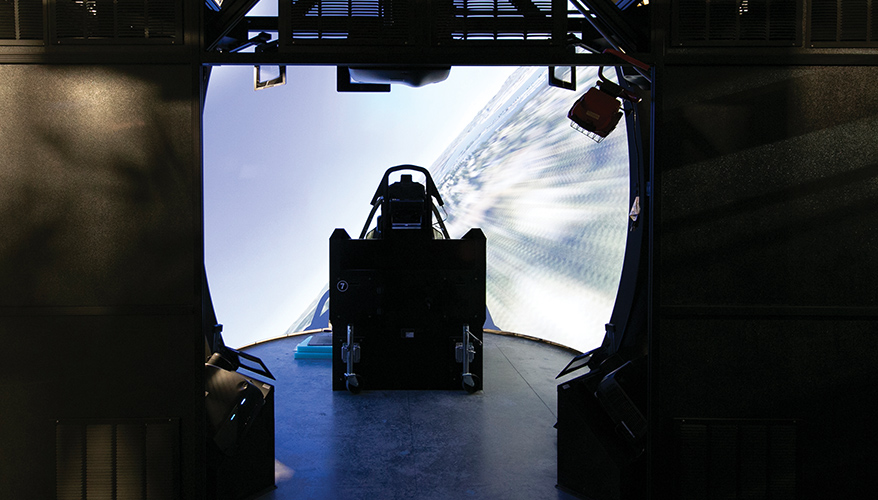TRAINING AND SIMULATION
Air Force, Navy Aircraft Simulator Facility Stretching Its Wings
By Laura Heckmann

Navy photo
ORLANDO, Florida — The government-owned Joint Simulation Environment — a facility used by the Air Force and Navy to conduct high-fidelity training — has become so popular demand has outgrown its Maryland headquarters, and an expansion is in the works.
The Joint Simulation Environment, or JSE, uses a physics-based computer environment capable of simultaneous interactions between manned aircraft simulators and thousands of virtual friendly and enemy air and surface entities.
The facility offers full fifth-generation aircraft assessments not possible on open air ranges and features realistic, high-fidelity simulators, said Derek Greer, head of the Integrated Battlespace Simulation and Test Department and Joint Simulation Environment at Naval Air Warfare Center Aircraft Division in Patuxent River, Maryland.
However, the location is not able to handle the demand for its service, he added.
“Unfortunately, we are having to tell people ‘no’ right now because our schedule is just too full,” he said during a panel discussion at the National Training and Simulation Association’s Interservice/Industry Training, Simulation and Education Conference in December. “So, we are doing something about that.”
Specifically, the Joint Simulation Environment is expanding. The program is working to scale the facility beyond Patuxent River with a multi-site concept made up of super sites, fleet sites, deployable sites and industry sites.
The super sites, which are planned to be operational by the end of 2025, will be facilities with “very similar capabilities as what our aviators are getting at Pax River,” Greer said.
The sites will be located at Edwards Air Force Base in California; Nellis Air Force Base and Naval Air Station Fallon in Nevada; and the Joint Integrated Test and Training Center in Alaska.
“In about one year, we are going to go from one site at Pax River to five sites spanning both coasts,” he said. All sites will include the “highest fidelity platform representation with ‘man in the loop,’ highest fidelity environment and threats, highest fidelity threat representation and support [for] high-end training,” a slide during the presentation read.
Greer said the super sites are going to “immediately fix our training model” and alleviate “some of the pressure on us and support training. And we’ll be able to get a lot more warfighters through our facilities.”
Another piece of the multi-site concept is scaling to other sites, called fleet sites, which will be less realistic with smaller footprints and require less hardware and support staff and will reinforce learning achieved at the super sites, Greer said.
These sites will “get this JSE high-fidelity environment closer to our warfighter, so think home stations for our U.S. Air Force and U.S. Navy F-35 bases” such as Hill, Luke, Eglin and Eielson Air Force Bases, Royal Air Force Lakenheath in the United Kingdom and “all the National Guard sites.” Expanding to these sites is “a few years out, but that work is taking place,” he added.
The environment’s deployable sites will include lower-fidelity, smaller-scale training solutions on board nuclear-powered aircraft carriers.
In June 2023, the first smaller, light version of JSE with F-35 components was deployed aboard the USS Carl Vinson aircraft carrier and has since been deployed on the USS Abraham Lincoln for the F-35, Advanced Hawkeye, Super Hornet and Growler aircraft, where it is “being used every single day,” Greer said. The team is working to deploy the system supporting the four aircraft on the Carl Vinson and the USS George Washington, he added.
Lastly, the plan includes industry sites — industry partners developing new capabilities in high-fidelity and common environments.
“The E in JSE … that is software,” Greer said. “The physics-based propagation, the threats, how we’re doing weapons, that is all software. And if you have an appropriate contract with the government or a [cooperative research and development agreement] in place, we will give it to our industry partners.”
Col. Matt Ryan, senior materiel leader of the Air Force Life Cycle Management Center’s Advanced Training Capabilities Division, called the effort a “pretty significant scaling challenge,” as the original Joint Simulation Environment was designed for a single purpose at a single place, “almost for a single point in time,” and is now being scaled out to be used “at many places, for all time, for almost all people.”
The past several years have been spent re-architecting the environment into a scalable solution that deploys “well to multiple sites,” he said.
The goal for the new operating sites is to get simulators and training caught up to reflect “whatever is in the fleet,” Ryan said. “And that’s absolutely going to take a partnership between us and industry to get over that hump.” ND
